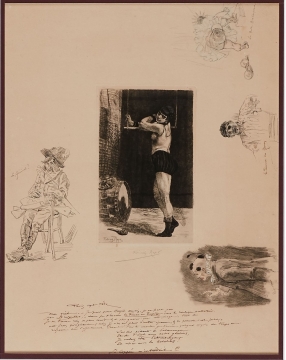The Heritage Fund has acquired 66 original works by Belgian artist Félicien Rops: 11 drawings, 8 engravings with texts in the margins, 43 engravings with drawings in the margins and 4 letters. This exceptional acquisition has further enriched the collection of the Félicien Rops Museum in Namur, where the works will be accessible to the general public.
Painter, draughtsman and engraver Félicien Rops (1833-1898) had the habit of adding original drawings or handwritten notes in the margins of his engravings in order to make them unique and thus increase their value. This technique, known as Marginalia, is a particularly original aspect of Rops’s work. The executional quality of the drawings and the number of works (with over 200 listed) mean that these engravings with drawings and/or texts can be considered not only as a particular feature of Rops’s creativity but also as an exceptional practice in engraving during the 19th century.
This ensemble of original works acquired by the Heritage Fund comes from the collection of Carlo de Poortere (1917-2002), who held the largest collection in the world of works by Félicien Rops.
In order to promote the works and make them accessible to the general public, the King Baudouin Foundation has entrusted the engravings and letters to the Félicien Rops Museum in Namur, where they will be exhibited with other, previously acquired works by Félicien Rops, including La Dame au Pantin, La Sphinge and Dans les Coulisses. Véronique Carpiaux, Conservator at the Rops Museum, commented: "This new long-term loan will enrich the presentation of the Namur artist in the museum. The so-called Marginalia relate to subjects that Rops broached throughout his career. The drawings in the margins, which are often erotic, bring a different vision to the value attached by the artist to each of his engravings and thus enable new scientific research to be conducted on the relationship between Rops and multiple art.”
Prior to being exhibited in the museum’s rooms, the new works are currently accessible virtually on the museum’s website. The texts in the margins of the engravings will be integrated into the website dedicated to Rops’s correspondence: www.ropslettres.be.
